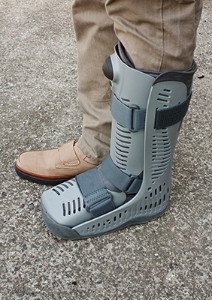
One out of ten broken bones is reported to be in the feet. When an object crushes, bends, or stretches the bone beyond acceptable ranges, bones break. A break in the foot is either a fracture or a straight break.
The location of any break can tell you how the break happened. Toes, for instance, break typically as a result of something being kicked hard and with great force. Heel breaks almost always are a result of an improper landing from a tall height. Twists or sprains are the other two frequent occurrences. As with all usual breaks, they result from unexpected accident or sudden injury. As with stress fractures, breaks form as a process over time from repeated stress on already present cracks. Runners, dancers, and gymnasts are the usual athletes who receive this type of break. Stress fractures result from incredible pressure on the feet. It is no surprise these athletes bear the majority of reported fractures.
Pain, swelling, bruising, and redness are all indicative of the typical symptoms from a broken foot. Severe pain—to the point of not being able to walk—usually depends on the location of the break in the foot. Toes are on the lower scale of pain threshold, but heels are high, as are a few other particular bones. As the severity of the broken foot increases, symptoms like blueness, numbness, misshaping of the foot, cuts, or deformities will become apparent. These symptoms indicate the need to see a medical professional with access to an x-ray facility.
Prior to seeing a specialist, precautions should be taken to reduce pain and swelling. Elevate and stabilize the foot, and refrain from moving it. Immobilization of the foot is the next priority, so creating a homemade splint is acceptable. Keep in mind that while creating a splint, any increase of pain or cutting off blood circulation means that the splint should be removed immediately. Use ice to decrease swelling and relieve pain symptoms.
When dealing with a medical center, the patient should note that the treatment can vary. The treatment will depend on the severity of the fracture and the cause of the break. Crutches, splits, or casts are common treatments while surgery has been known to be used in more severe cases in order to repair the break in the bones.
 A broken foot can be a common ailment that may occur in children. This can be a result of the bones in the feet that have not fully developed and are more fragile than the bones in the adult foot. If a broken foot occurs, noticeable symptoms often include severe pain, redness, swelling, and it may be difficult to walk on. Your child may find moderate relief when the affected foot is elevated, and a splint may temporarily be applied that can provide the necessary support. After a proper diagnosis is performed, which generally consists of having and X-ray taken, a cast or a protective boot is worn that can limit excess movement as the healing process takes place. If your child has fallen, and complains of foot pain, it is suggested that you consult with a podiatrist who can properly treat a broken foot.
A broken foot can be a common ailment that may occur in children. This can be a result of the bones in the feet that have not fully developed and are more fragile than the bones in the adult foot. If a broken foot occurs, noticeable symptoms often include severe pain, redness, swelling, and it may be difficult to walk on. Your child may find moderate relief when the affected foot is elevated, and a splint may temporarily be applied that can provide the necessary support. After a proper diagnosis is performed, which generally consists of having and X-ray taken, a cast or a protective boot is worn that can limit excess movement as the healing process takes place. If your child has fallen, and complains of foot pain, it is suggested that you consult with a podiatrist who can properly treat a broken foot.
A broken foot requires immediate medical attention and treatment. If you need your feet checked, contact one of our podiatrists from Grand Blanc Family Footcare. Our doctors can provide the care you need to keep you pain-free and on your feet.
Broken Foot Causes, Symptoms, and Treatment
A broken foot is caused by one of the bones in the foot typically breaking when bended, crushed, or stretched beyond its natural capabilities. Usually the location of the fracture indicates how the break occurred, whether it was through an object, fall, or any other type of injury.
Common Symptoms of Broken Feet:
Those that suspect they have a broken foot shoot seek urgent medical attention where a medical professional could diagnose the severity.
Treatment for broken bones varies depending on the cause, severity and location. Some will require the use of splints, casts or crutches while others could even involve surgery to repair the broken bones. Personal care includes the use of ice and keeping the foot stabilized and elevated.
If you have any questions please feel free to contact our office located in Grand Blanc, MI . We offer the newest diagnostic and treatment technologies for all your foot and ankle needs.